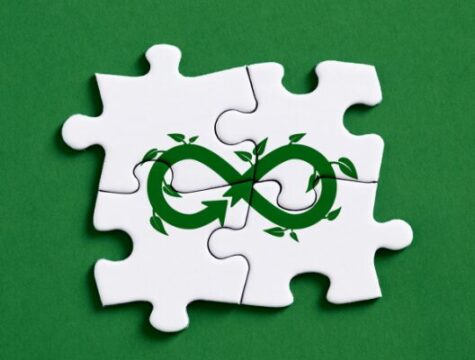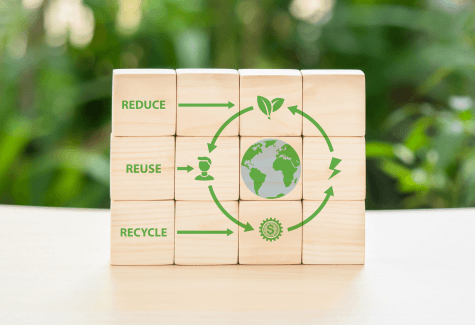Prepared together with Naveedh Ahmed Sekar, M.sc Environmental and Resource Management
Materials play a central role in the current Circular Economy debates. Biodegradable? Recyclable? Fair and transparent? Not toxic? Independently of an industry, search for the best material match to the product specification and function is a challenge. It remains the hot topic for designers, producers or recyclers. How does the material look like? How does the material perform? What does it consist of in order best way to recycle it?”
The circular economy holds a special view of materials. Biologically based materials as a part of the biological cycle are designed to feed back into the system. However, materials can be also part of the technical cycle through reuse, repair, remanufacture or recycling. Thus in the circular economy, the crucial question is: “what happens with a material at the product end of life?”
The current materials diversity does not simplify the answer. The speed of new materials’ development, especially, synthetic polymers with different compounds is enormous. For comparison, according to google.patent, if you search for the number of patents for plastic filled in 1970 you will have about 23,312 results; for the year 2015, the number reaches 670,738, which is registered annually!
Berlin “Green Lab – Laboratory for Sustainable Design Strategies”, a study program in Kunsthochschule Berlin Weißensee embraced the topic Circular Economy this year, where the students worked on the materials design inspired by Circular Economy ideas. The key focus was to innovate materials to substitute existing solutions across different industries, such as ceramic, textile, or some plastic materials on a non-toxic basis and simultaneously close the bio-loop of the circular economy. Such an interdisciplinary educational approach, combining design and materials development, empowered students with the knowledge on the current circular economy challenges.
We tend to believe that biobased materials are always the best option, however, it is not always the case. For example, fibers like cotton or jute depend on land, water, pesticides & post chemical usage. Unfortunately, use of chemicals, not applicable for the human health, appears during material processing and production. Juni Sun Neyenhuys (Project AL. G), developed an idea on the utilizing biodegradable Alginate from brown algae for various textile purposes extending its conventional use in medicine or food. Brown algae cultivation does not require arable land or pesticides as it grows in salty seawater. Juni considers that in the circular economy every single step from raw materials cultivation to their disposal must be taken into account.

Another textile-oriented idea came from Tau Pibernat (Project Our Local Nettle), who worked with nettle as a material. It was used nutritionally, medicinally and for textile production in Europe long before cotton. Using nettle can reduce the water amount for cotton agriculture. The project aims at the creation of European made nettle textile through further research cooperation. As a designer, Tau claims: “Designers are specialists combining different disciplines in the conception and production of consumer goods. They can gather all the different knowledge and create concepts that involve the complete system, not just the final product in isolation”.
Plastic was also the topic for GreenLab research. Ralph Zaehringer (Project New Tactility) approached the development of bioplastic pattern from citrus fruit peels. The peels leftover have been already used to extract biopolymers (pectin). The citrus biopolymers tactility properties are reinforced through special embossing or perforations to form patterns. The citrus bioplastics are biodegradable and have a low impact on the environment. Ralph mentions: “In the field of materials, we should think about “new qualities” offered by biopolymers instead of just replacing solutions. They need new applications and newly designed values”. Ralph would like to extend his tactility research further with scientists & producers.

Another interesting idea to innovate with new plastic material was presented by Jannis Kempkens in the plasticula project, who worked with ability of mealworms to digest and degrade Styrofoam. Beetles are mainly made out of chitin, which is the second most abundant biopolymer and appears in nature in many different forms and properties. It makes it a fantastic material to create biodegradable plastics. With such idea Jannis wanted to tackle the problems with plastic recycling and its pollution, focusing on foils. He did a research on the larva of a beetle, and found out, that mealworms can be a solution to another problem we have these days: feeding a growing world population. Thus his solution might close a gap in the growing industry of insect farming, which is already legalized in Europe, where beetles thrown away after their 2 months life.
What about other leftovers and material usability? Barr Cohen used eggshell waste in his Project Ei O2 to replace some non-recyclable material. Barr studied the material physically and searched for a binder, which does not detract material quality. He found that through mixing it with a biodegradable binder “Kaolinite” the durability of the material improved. A product plant pot was developed using the resulting material to replace the short-lived plastic pots. Barr believes that there is a need to raise awareness on biodegradable based product development among industrial designers for benefit of our planet.

Oyster shell waste can be also successfully used to build up surface structures. Thalea Schmalenberg developed this topic in the project Epithel. The challenge was not to collect the shells, but more within the process of cleaning and grinding them. Thalea cooperated with a local „Kollergang“ in Marzahn in Berlin to grind the shells manually. In combination with other ceramic fractures, such as tableware, the new material was developed fitting for 3D printing. Thalea said: “Being a circular designer, you take over responsibility. Not all designer think circular and I want to raise attention and work within that philosophy the rest of my career.”
Circular Economy requires a significant change in the educational approach through cross-disciplinary topics because to develop a circular economy project requires systemic view and involvement of different disciplines.
Circular Berlin wants to thank GreenLab designer students who agreed to share their results. The answers were shared with are very inspiring and we would like to give you full story behind it.



